
I really enjoy shuffling through fallen leaves in autumn. Walking through wet grass on a hot summer day is even better. But both pale before walking a lush moss-covered forest path.

I went for a long-for-me, 7.22-mile run this morning, and listened to a podcast about light therapy.
(I go back and forth on listening to podcasts during runs. When I listen I feel like I miss out on being fully embodied in my physical activity. When I don’t listen I fall behind on stuff I really want to listen to. Today I listened.)
The podcast had Paleo Magazineʼs Ashleigh Van Houten interviewing Scott Nelson, the founder of Joovv, talking about the health benefits of exposing your skin to red and near-infrared light. I’d heard about this, but had assumed it was some woo-woo new-agey thing. Turns out it’s probably not. There’s been a huge amount of research on the benefits of exposing your skin to red light in the 660-nanometer and near-infrared light in 850-nanometer range.
(There was apparently a lot of research funded by NASA back in the 1990s when they had to use lasers to get light of just the right frequency. Nowadays LEDs make it easy to get the intensity and frequency of light that you want.)
So, I’m out on my run, listening to Ashleigh and Scott talk about all the health benefits to your skin (of the red light) and to deeper connective tissues (of the near-infrared) and thinking that it all sounds really cool, but knowing that I’m probably never going to want to spend even hundreds, let alone thousands, of dollars to buy a device that will shine bright red light on my skin.
At around the mid-point, maybe 4 miles into my run, I paused for a drink of water out of the fountain in Morrissey Park, thinking it was pretty hot for just 8:40 AM . Which made me think of this giant glowing orb in the sky, which was shining down on me with pretty intense light at a wide range of frequencies, most definitely including red and near-infrared.
Turns out, sure enough—the energy in the red and near-infrared frequencies of sunlight is right in the range of therapeutic doses shown to have health benefits.
Of course, full sunlight is full of other frequencies of light, including blue (prone to mess up your circadian rhythm if you’re exposed too close to bedtime, but just what you want to get your circadian rhythm set correctly if you get your exposure in the early morning like I was doing), and ultraviolet (dangerous in excess, but the UV index was zero when I started my run at 7:40 AM and probably didn’t reach 5 before I was safely back indoors). So you need to treat sunlight with respect. But I already knew that.
I have mentioned before that I feel better when I spend a lot of time outdoors, and have speculated that sun exposure is part of the reason. (Along with time in nature, moving more, appropriate quantities of community and solitude, etc.) The information about red and near-infrared light exposure seems to lean a bit in the sunlight direction—but with the welcome news that it’s not just the vitamin D that helps make me feel better, which means maybe I can feel great without having to expose myself so much to the deadly actinic rays of the sun.
Maybe there are non-deadly actinic rays!
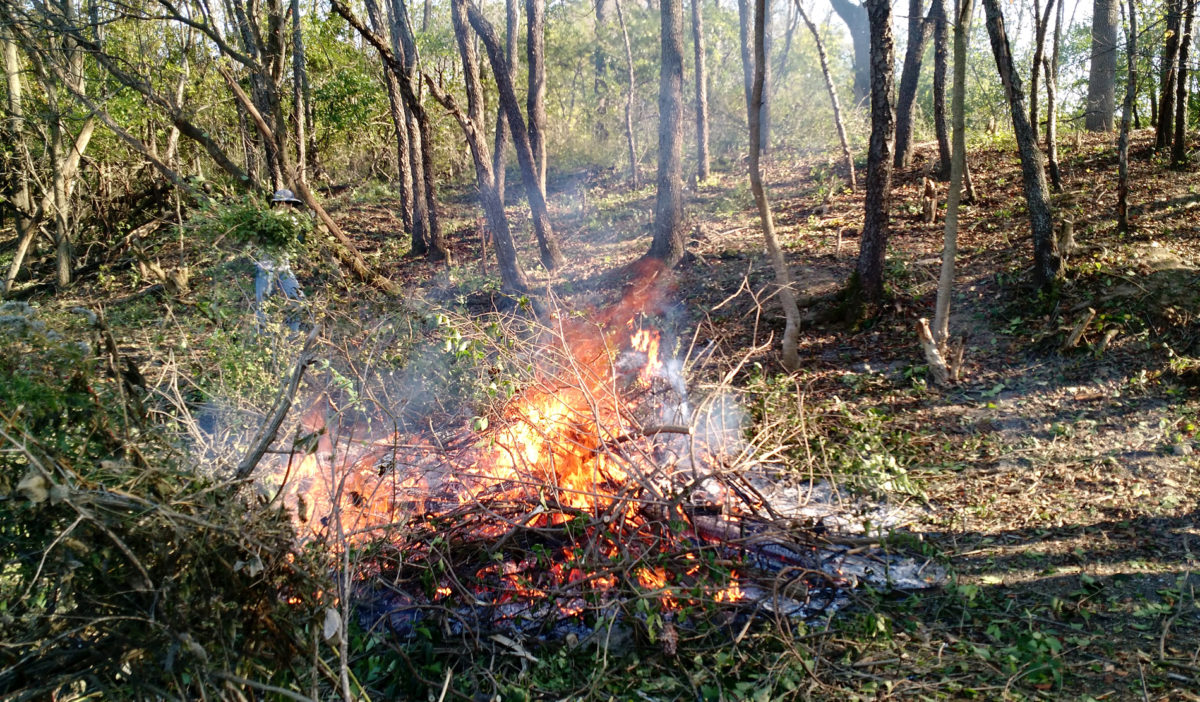
Last Thursday Jackie and I (along with several other Urbana Parks Department volunteers) spent a couple of hours clearing invasive bush honeysuckle at the Perkins Road natural area. (The photo is from a year ago. Sadly, we did not have a fire this time. We just piled the honeysuckle up in great huge brush piles.)
Like last time the work consisted of cutting and then carrying or dragging honeysuckle trunks and branches across a forest floor made rough by many tangled roots and littered with small stumps where honeysuckle had been cleared in past.
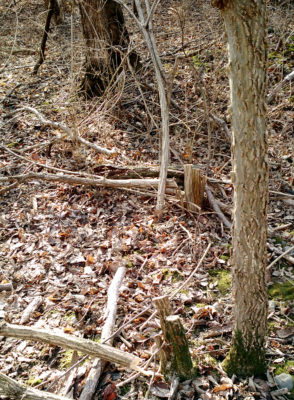 The next day Jackie commented that her feet were tired, and suggested that the stewardship work was more to the point than the various foot exercises suggested by movement teachers such as Katy Bowman and our new local Restorative Exercise Specialist Ashley Price. (Exercises such as rolling your foot on a ball or standing in boot trays filled with river rocks.)
The next day Jackie commented that her feet were tired, and suggested that the stewardship work was more to the point than the various foot exercises suggested by movement teachers such as Katy Bowman and our new local Restorative Exercise Specialist Ashley Price. (Exercises such as rolling your foot on a ball or standing in boot trays filled with river rocks.)
To which I said, “Yes! Exactly!”
Movement trumps exercise.
That’s not to say that exercises don’t have their place. Especially for people whose lifetime movement history has left them unready to safely perform certain movements, but also just for people whose schedule makes it hard to fit in as much movement as they’d like, exercises can be an excellent way to make yourself ready or keep yourself ready.
But to actually use your whole body capabilities to perform real work? To engage in bending, squatting, dragging, lifting, carrying—and do so while in nature, as part of a community effort, making the land better? So much better.
<whispering in Katy Bowman voice>Hashtag #VitaminN Hashtag #VitaminCommunity Hashtag #VitaminTexture</whispering> (This last will make no sense if you don’t listen to the Katy Says podcast.)
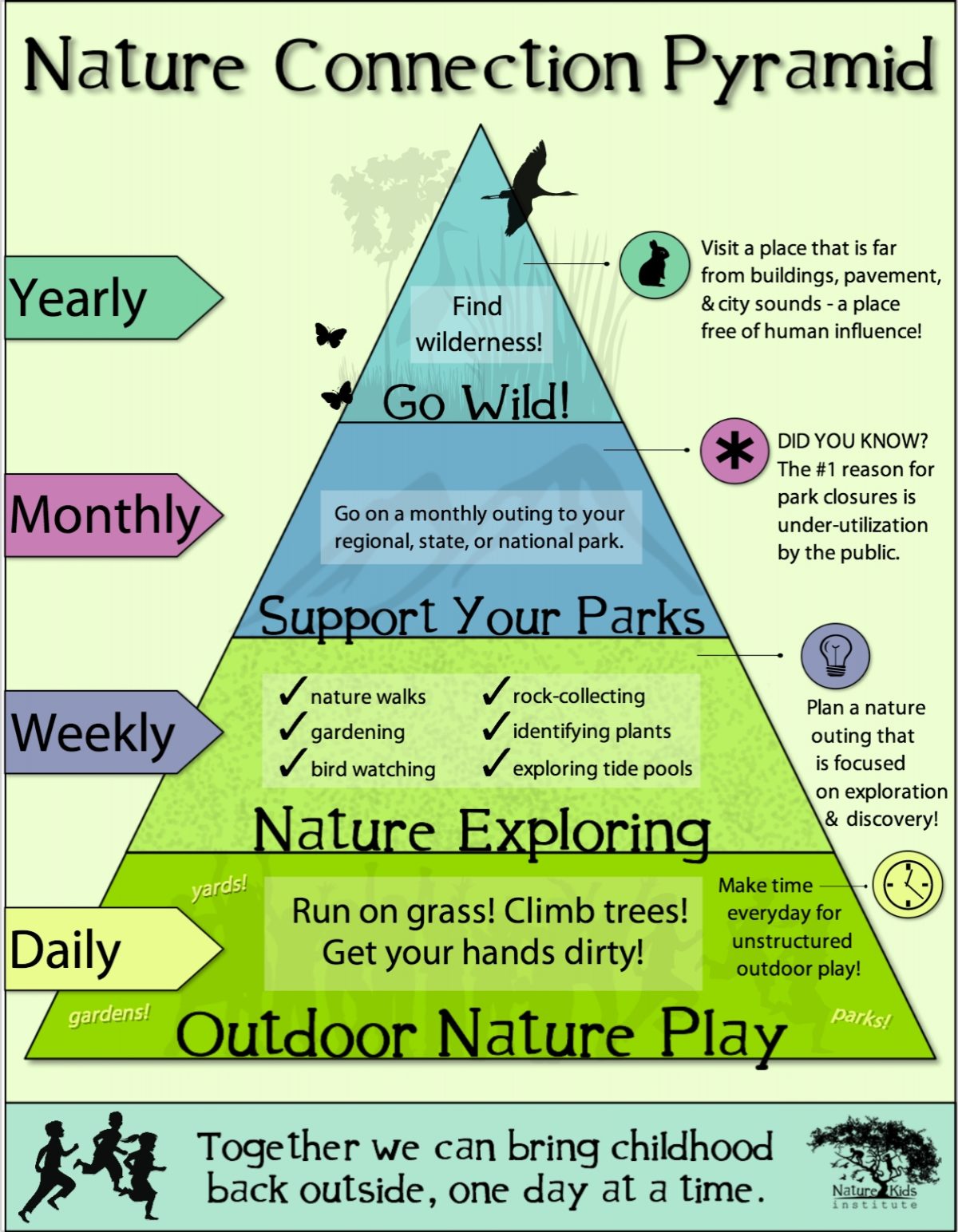
Via The Art of Manliness I found this great graphic of a nature pyramid (à la the food pyramid) at the Nature Kids Institute. It’s aimed at kids, but really the prescription for adults should be exactly the same.
It’s tougher in the winter, of course—when the grass is snow-covered and the paths are icy, they simply aren’t so runable or walkable. But that’s okay. It’s still worth getting outside.
It’s also tougher in Illinois to find wilderness than in most other places I’ve lived. There was real wilderness in Michigan and Indiana and Florida (although when I lived in Florida I did a pretty poor job of spending time in it), and of course vast amounts of real wilderness in Utah and California. Still, there are places in Champaign county where I can at least get out of sight and out of earshot of roads, even if it isn’t really free of human influence.
Anyway, these quantities seem like good initial target minimums for time in nature. Maybe not optimal, but adequate, and probably a lot better than most people manage.
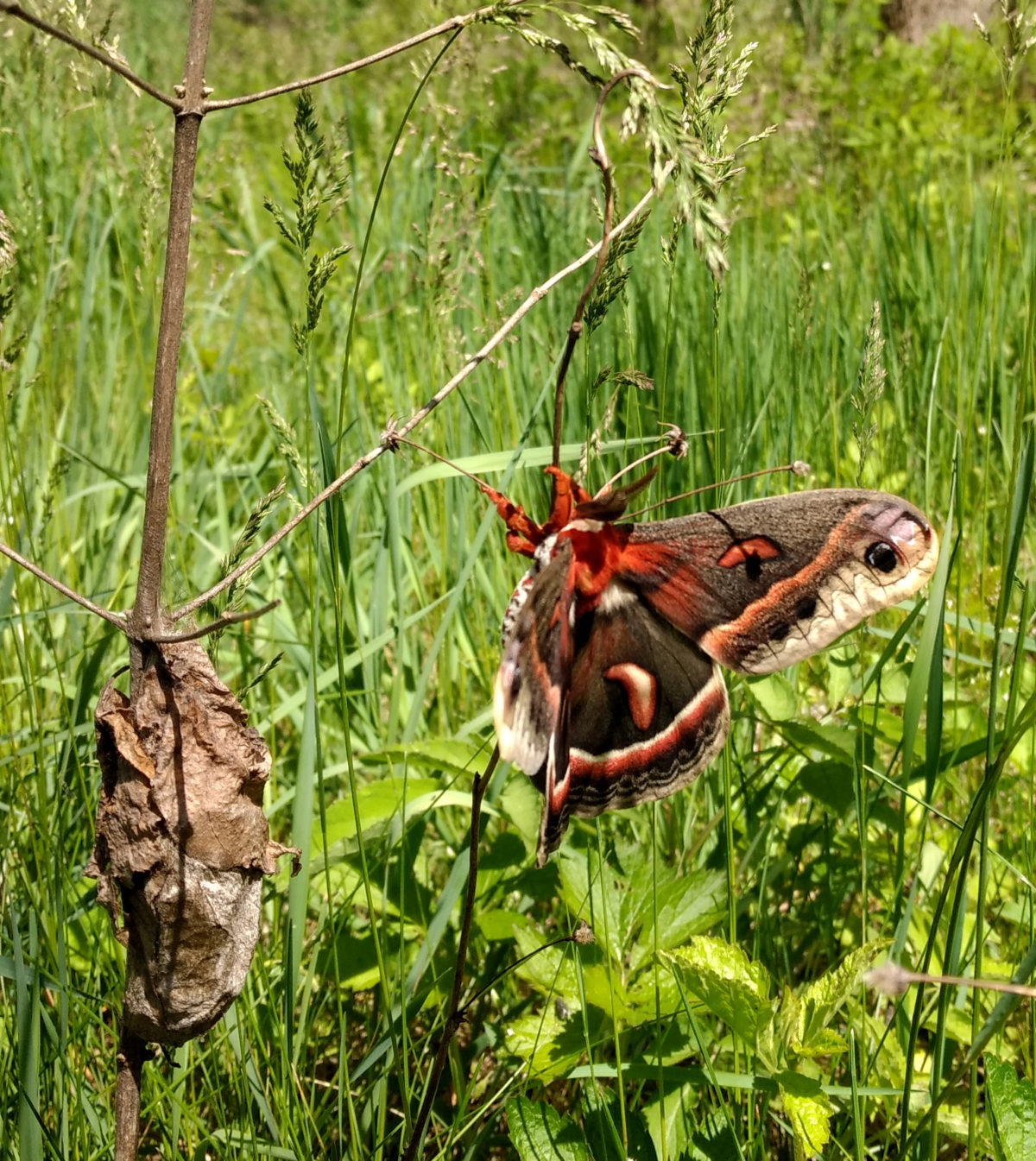
I’ve been occasionally joining Jackie when she does stewardship workdays at natural areas around the county as part of her Master Naturalist work. They’re fun, and they fit in very well with my shift away from exercise and toward movement. Our work Sunday, clearing garlic mustard from the South Arboretum Woods, is a great example.
(Garlic mustard is a nasty invasive, largely because the first-year growth leafs out very early, and covers the ground almost completely. Native plants emerge a little later in the spring, by which time they can’t get enough light to get going. The upshot is that the understory loses most of its natural diversity, becoming just a vast carpet of garlic mustard.)
What we did Sunday was make our way through the woods, spotting and then pulling up all the second-year garlic mustard. (It’s a biennial. The first year is the low ground cover. The second year it puts up a flowering stalk and produces seeds. If you can get the flowering stalks before they set seed, you can make a dent in the local garlic mustard density.)
What struck me was how similar our activity was to “gathering” à la hunting and gathering. It was physically similar—walking through the woods, and then squatting, bending, reaching, and pulling. It was also mentally similar—doing exactly the same pattern-matching that someone seeking to gather edible or medicinal plants would do.
I suspect that both of these aspects of this activity enhance the well-known beneficial effects of “forest bathing” (aka spending time in the woods).
The area we were clearing has a lot of downed branches, big and small, some partially or completely hidden by the ground cover, making for a complex walking surface—more good stuff for both the body and the brain.
Of course, volunteering for and participating in a stewardship work day produces all sorts of additional benefits—in particular, doing something good for the local communities (both the human community that uses the space and the natural community that inhabits it) is rewarding, as is making social connections with the other volunteers and engaging together on a common effort.
Every time I do one, I am reinforced in my desire to do more stewardship workdays, despite my slothful nature.
(The picture at the top is another view of the Cecropia moth that Jackie spotted while we were there.)
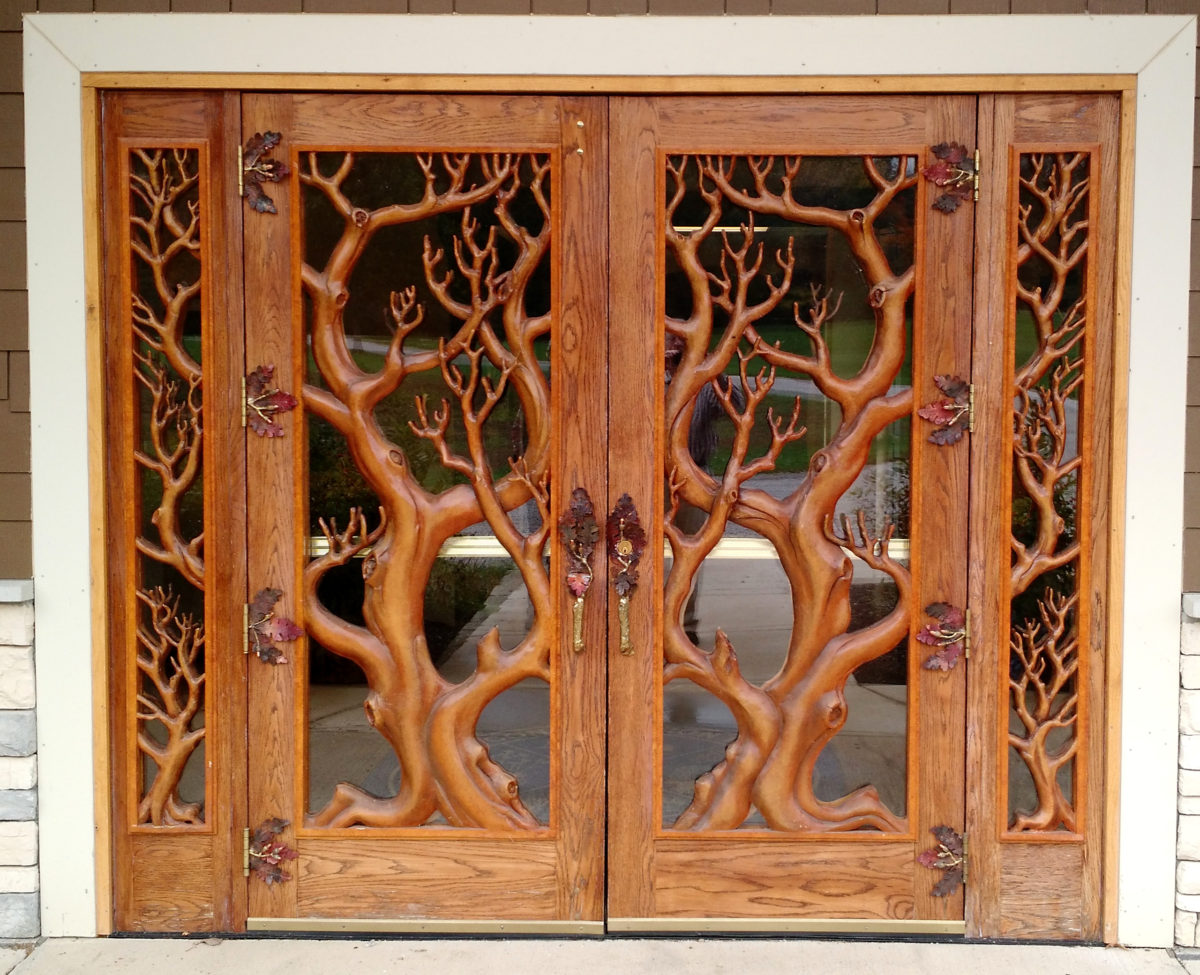
Even though I’m finding my self-care regimen for seasonal depression pretty adequate these days, I’m always interested in more tools. One thing that caught my attention recently was an interview with Brant Cortright in which he talked about his book The Neurogenesis Diet and Lifestyle.
Cortright has a bunch of interesting things to say, one of which I already knew: that depression is not a disorder of serotonin deficiency. According to him—and this I did not know—the way SSRIs work is by promoting neurogenesis. In the interview he said that depression turns out to be caused by a lack of neurogenesis, as are several other disorders (e.g. Alzheimer’s).
I checked the local libraries for copies of his book without success, but in my searches I happened upon this article: Successful brain aging: plasticity, environmental enrichment, and lifestyle by Francisco Mora, which seems to cover pretty much the same ground.
People are looking very hard at drugs besides SSRIs to promote brain plasticity, but the whole idea sounds problematic to me, so I’m interested in the various non-drug interventions suggested by Cortright and Mora. Fortunately, it seems that neurogenesis is easy to increase, by doing the obvious things we already know about:
I think of my artist dates in particular as environmental enrichment, but of course time spent in nature counts as well. The parkour I do probably counts double, because there’s learning how to execute the moves, but there’s also learning to see the environment as a place where those moves are useful.
My weight loss practices have been substantially motivated by the science around calorie restriction as a way to improve health generally, with additional neurogenesis just one factor.
My experience over the previous 30 years convinced me that approaching calorie restriction in a numerical, analytical fashion—tracking what I ate, estimating the calorie content, aiming for some target X% below maintenance—would be unsuccessful. Instead, I came at it from the other direction: If I’m losing weight, I must be restricting my calories.
The caloric deficit implied by my weight loss over the past five years is just about 100 calories per day. Maintenance for me is probably around 1800 calories per day, so I’ve averaged about 5.5% below. It would probably be more accurate to say that I’ve averaged about 10% below maintenance for about half that time, as I’ve generally lost weight during the summers while maintaining a stable weight through the winters. Either number is well shy of the “20% to 40%” reduction that’s been shown to decrease the rate of aging of the brain, but I rather suspect that the benefit exists even at these lower levels—with the added bonus of being sustainable over a much longer period of time. (I mean, how long can you maintain a 40% deficit below maintenance before you simply waste away?)
According to Mora, aerobic exercise seems to increase neurogenesis by the same chemical pathways as calorie restriction. According to Cortright, it has to be aerobic activity of substantial duration—some twenty minutes or more. In particular, the sort of HIIT workouts so beloved of the paleo/primal folks don’t seem to produce the same effect. That’s fine with me: Humans are much too well-adapted for endurance running for me to buy into the idea that primitive humans didn’t do marathon-distance runs when they needed to. Besides, I enjoy long runs.
Of course, neurogenesis is reduced by the obvious things:
My parents made a considerable effort to keep me and my brother free of neurotoxins, and I have managed to avoid concussions so far. I’m sure I subjected myself to excessive blood glucose levels for years, but I think I’ve got that under control now. I also subjected myself to excessive levels of stress for years, due to the vicious circle of my seasonal depression making me unproductive, my lack of productivity making me stress about losing my job, and the stress no doubt worsening my depression. I’ve got that under control now as well.
Really then, this whole neurogenesis thing doesn’t so much give me new strategies for staving off depression, as provide a conceptual framework for organizing the strategies I’m already using.
Even just that seems worthwhile.
(The image at the top is of these great doors at the Environmental Education Center at Kennekuk County Park. The branching trees reminded me of neurons, a little.)
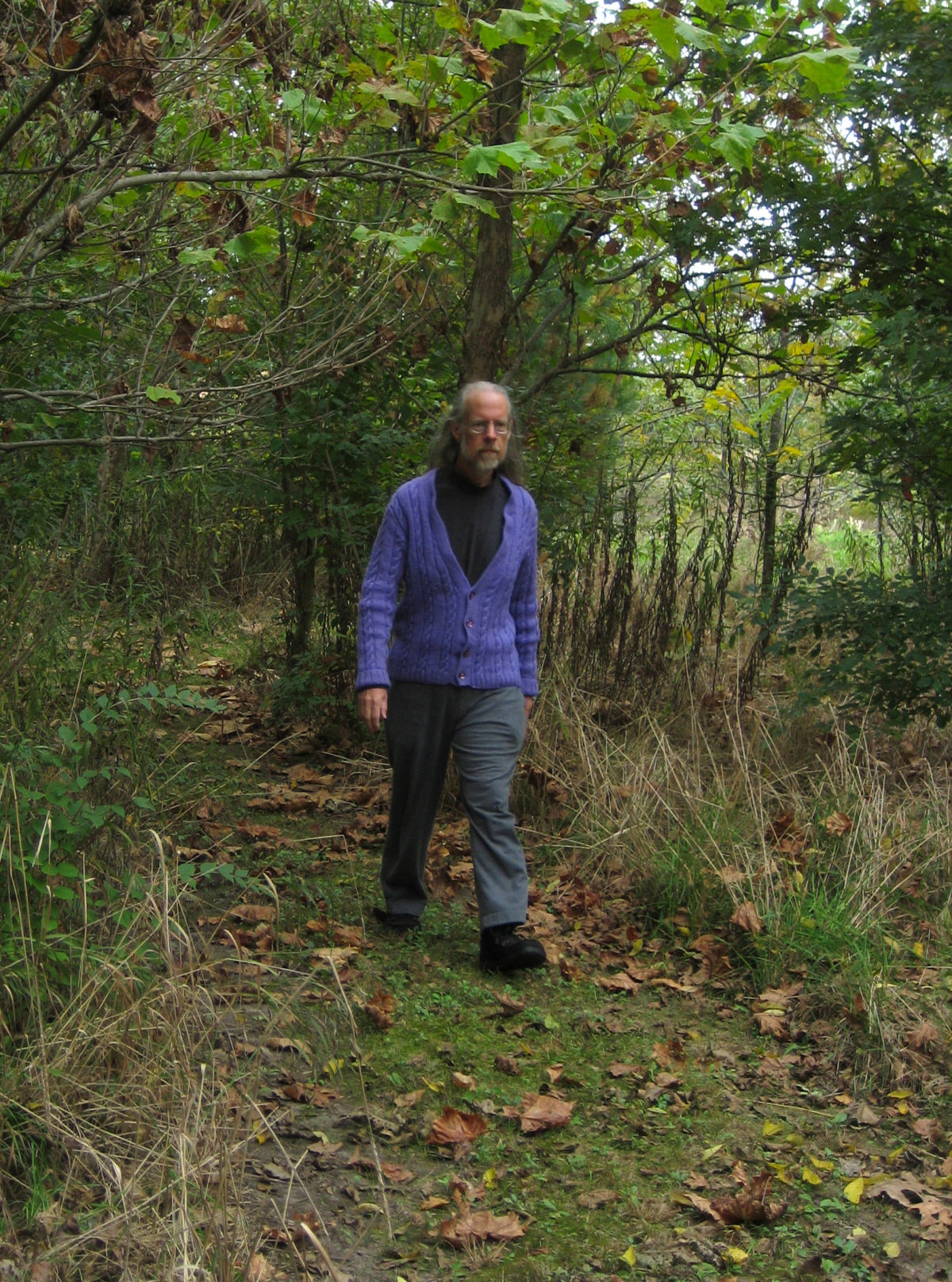
I do a lot of things to stave off winter depression. I walk. I spend time in nature. I spend time walking in nature. I move in other ways—taiji, lifting, stretching, running, parkour. I use my HappyLight™. I take vitamin D. But probably most important is finding things to take delight in.
Jackie doesn’t suffer with the dark days of winter the way I do, which is probably a matter of brain chemistry, but perhaps another factor is that she is very good at taking delight in winter as an opportunity to wear her woollies.
I’m trying to do the same.
It helps that I have new winter clothes, and old winter clothes that fit again. The photo on this page shows me walking in nature, wearing a purple sweater my mom knit for me years ago.
Besides my old sweaters and my new sweaters, I have a smashing wool vest that Jackie gave me, some wool pants that I bought as field pants (but that are perhaps too nice to wear in the field), and a vast collection of scarves that Jackie wove and knit for me. And that’s just the woollies. I also have a nice collection of moleskin and flannel garments perfect for winter, various fleecy things, and a range of jackets and coats to cover all possible temperatures from “slightly brisk” to “well north of the arctic circle.”
This year, I’ll try to take delight in my seasonally appropriate garments, especially the woollies, and see if that won’t carry me through to spring.
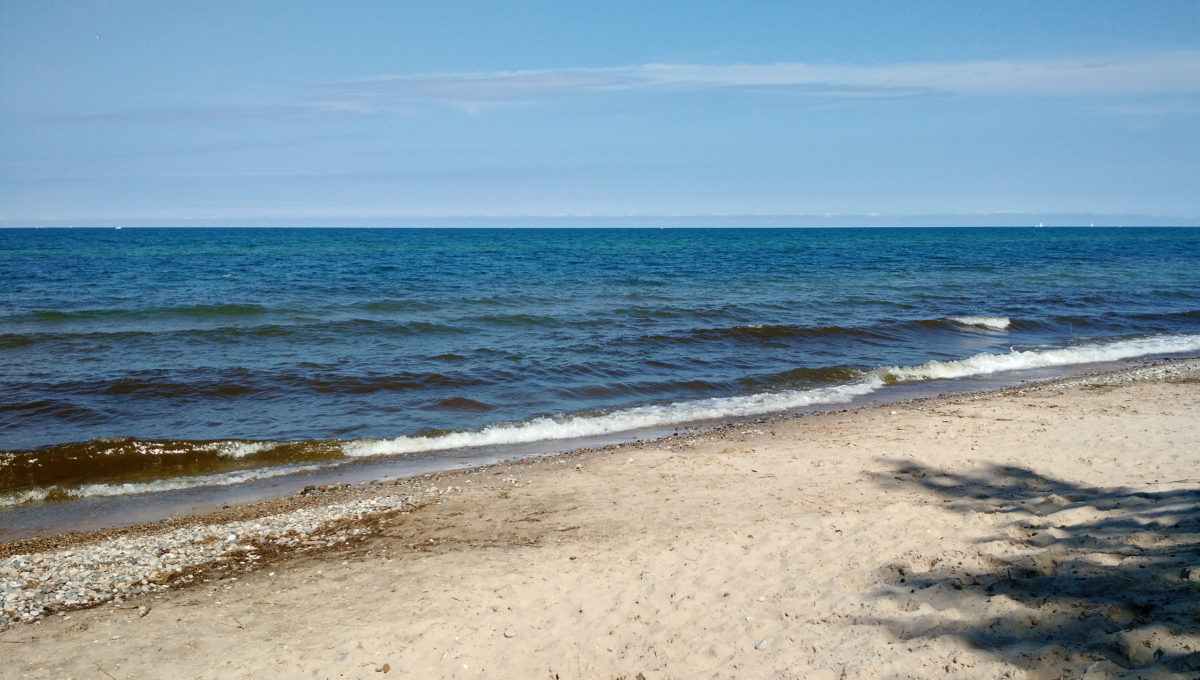
Lake Michigan isn’t great for swimming—the water is still pretty cold even in August, it’s kind of polluted, it lacks the extra buoyancy that comes from the salt in ocean water, and there’s no coral. But if what you want is a beach, Lake Michigan has a great one.
Eight years ago my brother convinced me to come to St. Croix for a family reunion sort of thing. We stayed at Cottages by the Sea. The meticulously kept grounds invited barefoot walking, and I was surprised to discover that a week walking barefoot in the grass and the sand cured my plantar fasciitis. (I’d been keeping it under control with Birkenstocks, supportive shoes, rationing the amount of standing I did on hard floors, and strictly limiting the amount of barefoot walking I did. Discovering that barefoot walking on natural surfaces helped rather than hurt was a key early step in my move toward natural movement.)
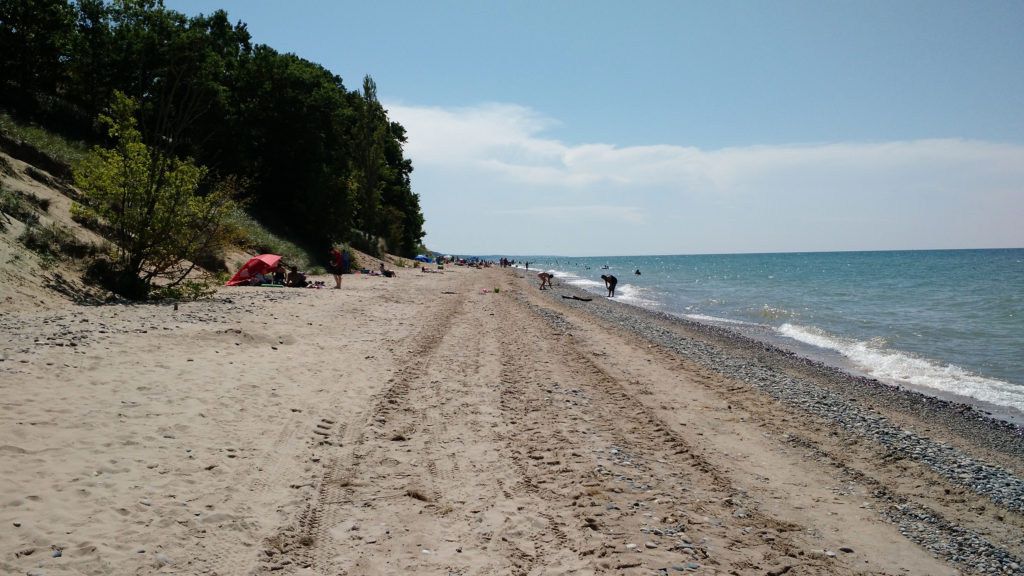 The Lake Michigan beach has some rocks right down in the surf, but they’re not an obstacle to comfortable walking, because they’re resting on sand and push right down when you step on them (unlike the rocky beach in St. Croix, which seems to be exposed bedrock with a little sand on top). And anyway, just a few feet up the beach from the surf, it’s just sand.
The Lake Michigan beach has some rocks right down in the surf, but they’re not an obstacle to comfortable walking, because they’re resting on sand and push right down when you step on them (unlike the rocky beach in St. Croix, which seems to be exposed bedrock with a little sand on top). And anyway, just a few feet up the beach from the surf, it’s just sand.
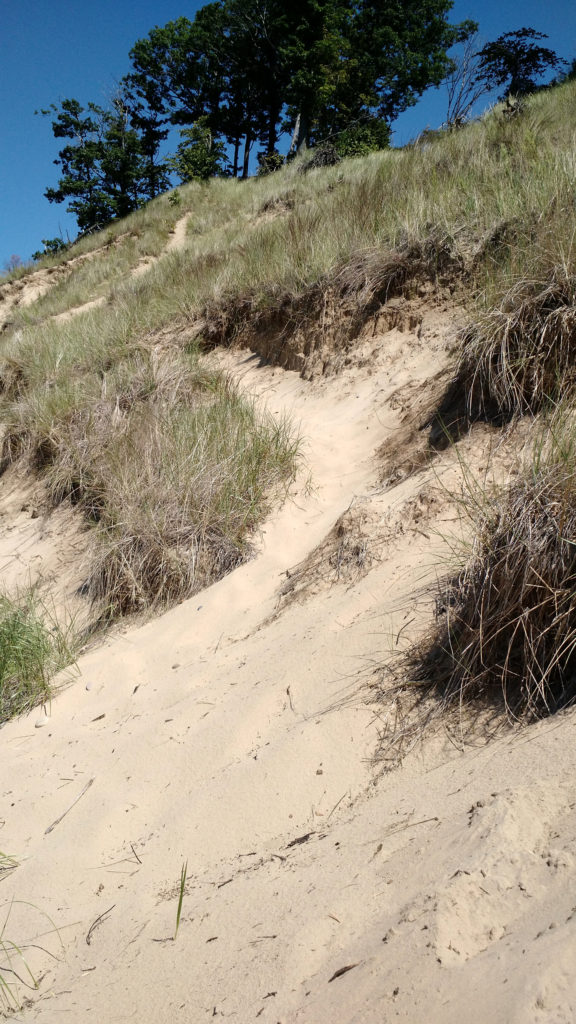 Rather a lot of sand, actually. Whole dunes of it. It’s beautiful along the lake.
Rather a lot of sand, actually. Whole dunes of it. It’s beautiful along the lake.
Champaign-Urbana is a great place to live, but it is lacking in beach, so I was glad to get a chance to visit the beach while visiting my dad last week. We drove to South Haven, visited a small nature preserve, and then went to the Van Buren State Park just south of the preserve. I did some beach walking both places.
I loved walking in the sand—soft, comfortable, hot (up where the sand is dry), cool (down by the water), and mildly abrasive. My feet enjoyed it even though my plantar fasciitis is long gone, cured by the taiji practice (standing meditation turns out to be a great way to learn how to stand), and by plenty of barefoot walking on natural surfaces.
 It only occurred to me recently that my feet being shoe-shaped (rather than foot-shaped) was a bad thing. I’d some years ago started down the path of “barefoot” running (that is, running in minimalist running shoes), but I’d been focusing on improve my running gait, rather than the shape of my foot.
It only occurred to me recently that my feet being shoe-shaped (rather than foot-shaped) was a bad thing. I’d some years ago started down the path of “barefoot” running (that is, running in minimalist running shoes), but I’d been focusing on improve my running gait, rather than the shape of my foot.
Once I started walking actually barefoot, I quickly developed an odd callus on the pad of my left index toe. And, looking at my feet, you can see why. Just the bit of barefoot walking I’ve done over the past couple of years has almost normalized my right big toe, which now comes out almost straight from my foot. My left big toe is still canted over at an angle so that it presses up against my left index toe. No wonder I use the toe oddly in a way that produces the odd callus.
Well, something to continue working on.
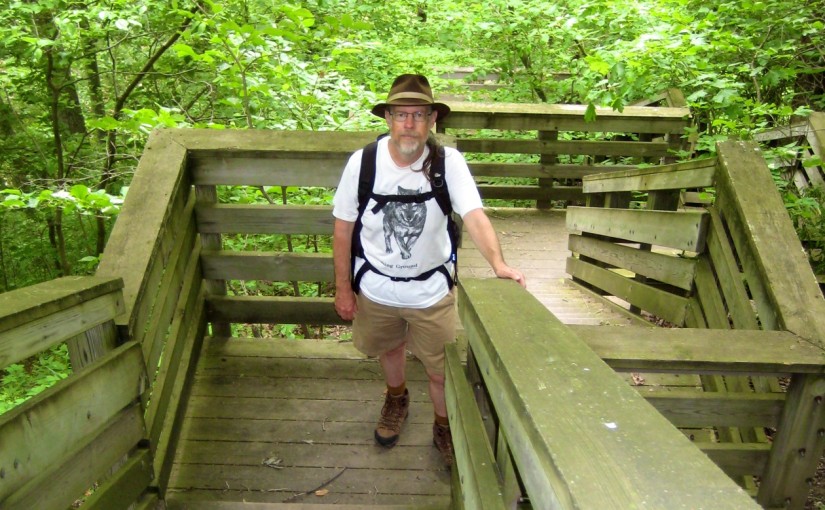
We’ve decided not to do another even longer walk before we do the big hike of the Kal-Haven trail. (Coming up later this month!)
I’d had it in my head that we’d do a 30-mile walk, but the more I thought about it, the less it appealed. Mainly, it seemed like it would make the main event less special. (“Oh. We walked 3.5 miles longer than our longest training walk. Big deal.”)
We will do one more walk of close to marathon distance, somewhere in the 20–25 mile range, but besides that, we’ve been doing some shorter walks of a more rugged nature, hoping to address some deficiencies that cropped up on the marathon-length walk.
In particular, I noticed that toward the end of really long walks, my hips get tired and seem kind of wobbly when I walk over uneven ground. I thought one way to address that, besides doing more longer walks, would be to find some especially uneven ground to hike on. That’s why we went to Fox Ridge and later to Forest Glen—the trails would let us get in some longish walks with some slightly different sources of stress than just more longer.
Today we hiked at Allerton Park, doing a bit over 6 miles of some not-too-rugged trails. We’d had it in our heads to do 6 more miles on the other side of the Sangamon River, but decided to skip it due to schedule constraints—we would have had to rush to get home in time to got to my Esperanto meeting and the farmers market this evening.
Besides the hike, we also took half an hour or so to do some taiji in the Fu Dog garden. That was very nice.
Once again, I got to put my parkour practice to use.
There’s a path that leads—used to lead—to the back of the mansion, and there used to be an iron spiral staircase that got you up to the top of a retaining wall the separates the grounds (at one level) from the steep slope down into the forest and the Sangamon.
We hiked up that trail—what’s left of it—only to find that the iron staircase has been removed.
The wall there would be beyond our capability to climb, but just around the corner (separating the mansion grounds from the pond), the wall is shorter—about chest high.
It’s been a long time, but I just did what I would have done as a boy facing a wall of that height—I put my palms on it, then jumped up high enough that I had enough leverage to go ahead and push myself up onto the wall.
Jackie found that she couldn’t jump high enough to get to where she could push herself on up, so she reached over the top of the wall to where she could hook her fingers over the far side. Then she just scrabbled up as best she could, her boots sliding on the bricks, but catching enough that she managed to get herself up onto the wall.
We were both pretty pleased with ourselves. I doubt if we could have climbed that wall five years ago.
I neglected to get a picture of the wall from today, but here’s a picture from a few years ago, looking across from the far side of the pond (click to embiggen):
 We were way over on the right, and our climb was from just above the pond. (There are two walls there. We just climbed the lower wall. There’s a path at that level, and then a second retaining wall up to the level of the mansion grounds proper.)
We were way over on the right, and our climb was from just above the pond. (There are two walls there. We just climbed the lower wall. There’s a path at that level, and then a second retaining wall up to the level of the mansion grounds proper.)
On an unrelated note, today seemed to be Path Crossing Day for the snails. I scarcely took a step down the path without seeing a snail.
Here’s the first snail I spotted:
Jackie and I went to the Forest Glen Preserve, a nature preserve in eastern Illinois, over near the Indiana border.
We scouted the campgrounds, because the local Esperanto group is planning to some tendumado. We found two, although there’s at least one more.
One is a pretty ordinary Midwestern campground with a mixture of tents and RVs. It was pretty full, but only as crowded as you’d expect on Saturday morning of Memorial Day weekend. It had showers and flush toilets, firewood on sale, etc.
Near that one (but far enough away that noise wouldn’t be a problem) was the “tent campground.” It was different in that it didn’t have parking spaces for the campsites. There was an area just a few yards away where you could leave your car for up to 20 minutes to unload, and then you were supposed to move it to a parking area that was still really quite close—I’ve carried my luggage further in a hotel. Still, it seemed to be enough to discourage campers. Even Memorial Day weekend, there was nobody there—sixteen vacant campsites. (It did lack flush toilets. Also, the recent rain had left some of the campsites under water, although the dry sites were also vacant.)
Once we’d scouted the campgrounds, we went for a hike. We picked the Big Woods trail, which a posted list had described as the most rugged of the preserve’s trails. We took that with a grain of salt. Here in the flatland, pretty much any change in elevation seems to qualify a trail as rugged, but it was somewhat rugged. The train went down twice into ravines, then back up again, and ended at an observation tower at what I assume is the high point of the preserve.
We saw plenty of neat stuff—sugar maples and tulip trees, white oak, sassafras, ferns, various kinds of mushrooms. (I saw what might be the tallest sassafras tree I’ve ever seen. It was huge. I usually think of sassafras as being scrubby little things.)
The trail was muddy, but only very muddy in a few places (plus, of course, the places where it crossed running water). We ran into three very wet, dirty guys with tools who said they’d been doing trail maintenance.
The trail was only a little more than 1 mile, but out-and-back so we got in maybe 2 ¼ miles of hiking.
We left it at just that much hiking, because we still needed to go to the Viking Reenactment, which was the reason that we were visiting Forest Glen this weekend in particular.
Two of the reenactors seemed to focus on fiber crafts. One is a member of the spinners and weavers guild, and was using some of Jackie’s handspun yarn to demonstrate weaving with a warp-weighted loom. We had a fun chat.
The other fiber-crafty person told us about her theory of mud-colored peasants. Many reenactors, she said, end up with clothing in colors of sheep, because dyeing fabric is another whole skill that you need to learn—and making your own natural dyes is two or three more skills (growing or gathering dye plants, and learning how to prepare them for dye use). However, in her experience meeting actual modern-day poor peasants, even the really poor ones go to considerable effort to not be the color of mud. Hence, she proposed, actual Viking-era villagers probably wore clothing that was as brightly colored as possible, within the limits of the natural dyes that were available to them. (They had several sources of yellow, yellowish green, red, and purplish red. Blue was available. A really good green was tricky, because you had to get a good yellow and then overdye with blue.)
Despite her theories, all the other reenactors seemed to be wearing clothing in natural colors.
What with scouting and hiking and viking, it was already lunch time. We had lunch at Gross’ Burgers, then headed home (pausing just a bit at a rest stop to let a severe thunderstorm pass).
A good outing.